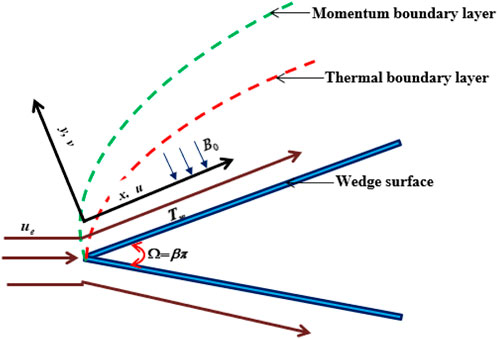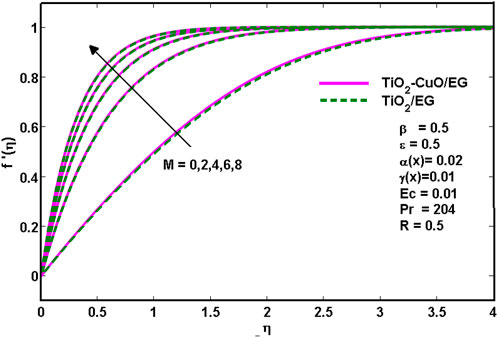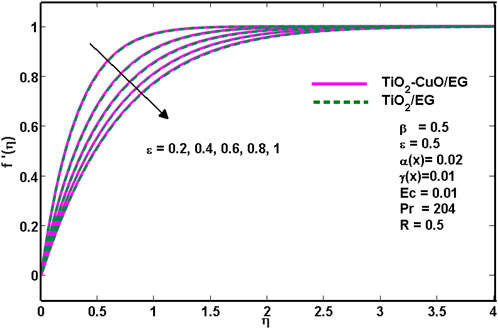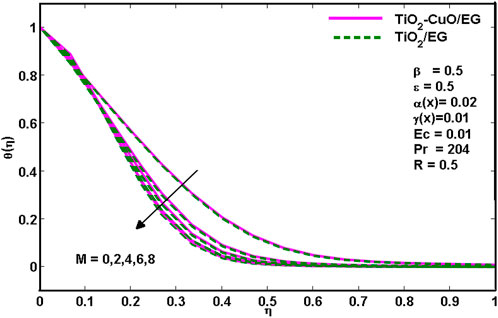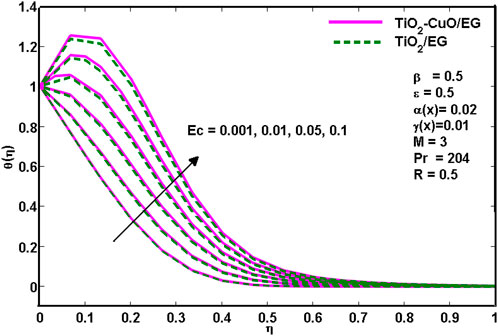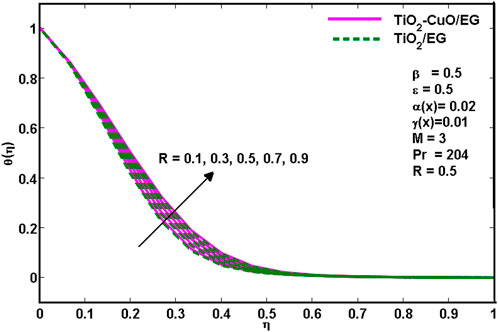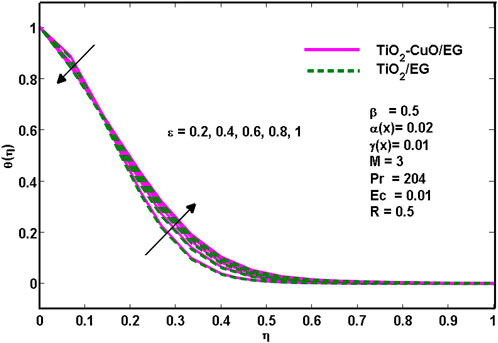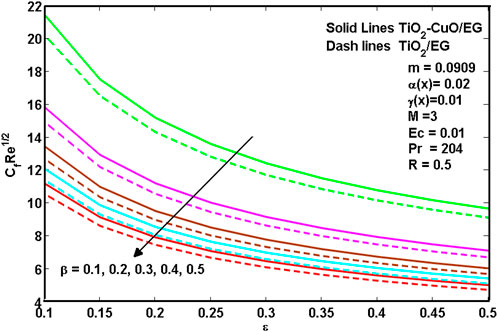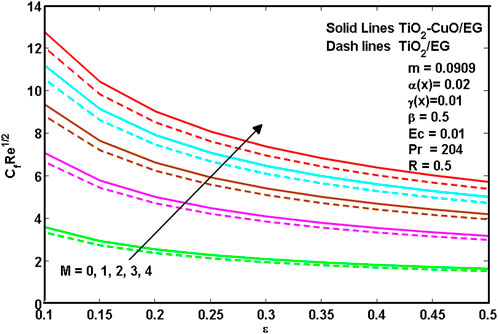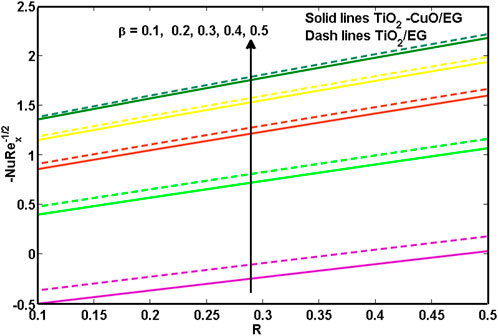Forced convection of non-darcy flow of ethylene glycol conveying copper(II) oxide and titanium dioxide nanoparticles subject to lorentz force on wedges: Non-newtonian casson model
- 1School of Mathematics and Statistics, Xi’an Jiaotong University, Xi’an, China
- 2Department of Mathematical Sri Ramakrishna Engineering College, Coimbatore, India
- 3Department of Mathematics, Providence College for Women, Coonoor, India
- 4Department of Mathematics, PSG College of Arts and Science, Coimbatore, India
- 5Department of Mathematics, Sri Ramakrishna Mission Vidyalaya College of Arts and Science, Coimbatore, India
- 6Department of Mathematics, Quaid-i-Azam University, Islamabad, Pakistan
- 7Faculty of Engineering and Technology, Future University in Egypt New Cairo, New Cairo, Egypt
The topic of two-dimensional steady laminar MHD boundary layer flow across a wedge with non-Newtonian hybrid nanoliquid (CuO-TiO2/C2H6O2) with viscous dissipation and radiation is taken into consideration. The controlling partial differential equations have been converted to non-linear higher-order ordinary differential equations using the appropriate similarity transformations. It is demonstrated that a number of thermo-physical characteristics govern the transmuted model. The issue is then mathematically resolved. When the method’s accuracy is compared to results that have already been published, an excellent agreement is found. While the thermal distribution increases with an increase in Eckert number, radiation and porosity parameters, the velocity distribution decreases as porosity increases.
1 Introduction
A solid-liquid dispersion of 1–100 nm sized nanoparticles or nanofibers makes up nanofluids. Due to the distinct physical and chemical properties of nanometer-sized particles, nanofluids have a wide range of commercial uses. Because of the improvement in their thermal properties, nanofluids have gained a lot of attention. This area has been the subject of extensive research. Fluids with low thermal conductivity include blends of water, oil, and ethylene glycol. These liquids serve as a cooling technique that boosts productivity and lowers operational expenses. Ahmadi et al. (2018) reviewed theoretically and experimentally the influential parameters on the heat conductivity of numerous nanofluids. According to their results, greater temperatures and nanoparticle concentrations typically result in nanofluids with better thermal conductivities. Philip et al. (2016) examined nitrate salts doped with CuO nanoparticles for thermal energy storage with better heat transmission problems. Shaw et al. (2022) studied boundary layer flow caused by radial stretching in TiO2 nanotubes-water nanofluid. They observed that the momentum transmission of that nanofluid is controlled while using the non-Newtonian fluid model. Aladdin and Bachok (2020) reported the range of dual solutions expand widely for suction and closely reduce for solid volume fraction of Al2O3 and TiO2 nanoparticles. Nishant and Shriram (2016) found that the total heat transfer coefficient and thermal conductivity of water and ethylene glycol-based nanofluids by the use of CuO and TiO2 nanoparticles are enhanced.
A hybrid nanofluid is made up of a base-fluid and two or more nanoparticles. A new class of such mixtures known as hybrid nanofluids has just been created. Compared to nanofluids, this class of materials has more effective heat transfer characteristics. Eshgarf et al. (1959) provided an excellent review of hybrid nanofluid properties, preparation, models, and stability. They found that the hybrid nanofluids had much better thermal conductivity than the traditional nanofluids (single particles). Additionally, it was shown that the choice of base fluid affects the thermal conductivity of the hybrid nanofluids. Mishra et al. (2022) observed that the Cu-Al2O3/EG hybrid nanofluid flowing through a rotating channel exhibits a considerable increase in the shear rate as well as the rate of heat transfer. Khashi’ie et al. (2022) investigated the thermal progression of a second-grade hybrid Cu-Al2O3/CH3OH nanofluid towards a permeable surface. It has been shown by Alhowaity et al. (2022) that the velocity and heat conduction rate through a stretching surface are greatly increased by the dispersion of copper and graphene nanoparticulates into the base fluid ethylene glycol using a power-law non-Newtonian model.
There are numerous thermal engineering applications where fluid flows across wedge-shaped bodies happen, including geothermal systems, crude oil extraction, thermal insulation, heat exchangers, and the storage of nuclear waste, etc., Holden (1970) done an experimental as well as the theoretical review on boundary layer flow on wedge, flat plate and sphere in 1970. Both the joined and detached interaction zones over the models were thoroughly examined by them. He resulted that the separation first happened on the compression surface downwind of the flat plate and that it was not always possible to determine early separation by looking for the first time that a pressure distribution inflexion point appeared. Romanov and Kolesnikova (2021) reviewed the boundary value problems past a wedge and briefly discussed on the properties and applications. Xiu et al. (2022) evaluated the forced convection flow of water-based ternary hybrid nanofluid on wedge surfaces at various temperatures with a focus on the comparative examination of large and small volume of nanoparticles. It was found that forced convection flow on wedges has higher friction linked with higher velocity as time grows long, regardless of whether the volume of nano-particles is large or tiny. Ali and Abdul Alim (2022) investigated above the wedge surface and finalised that, particularly mixed convection, thermophoresis and heat generation parameters, have no effect on skin friction. Haq et al. (2022) researched and discussed that the increment in angle of rotation enhances the local Nusselt number.
Convection is the movement of fluid that allows heat to move from one location to another. Convective heat transfer combines the processes of conduction and advection, although it is frequently mentioned as a separate type of heat transfer. Convective heat transfer plays a significant role in processes involving high temperatures. Convective boundary conditions are more useful in material drying, transpiration cooling operations and other industrial and engineering processes. In a forced convection mechanism or kind of transport, fluid motion is produced by an outside source. Many researchers have participated in the investigations into the impact of forced convection as a result of the outstanding concept. Khurana et al. (2017) reviewed on TiO2, CuO, Al2O3 forced convection thermal transfer and resulted that the researchers employed less than 3% volume concentration in their tests because nanofluids can improve heat transmission at low particle concentrations. Cui et al. (2022), Khan et al. (2022), Yasir et al. (2022), Ahmad et al. (2022), Hoi et al. (2022), Zhang et al. (2022) have studied the role that the effect of forced convection plays on different fluid kinds and surfaces.
Radiation is the release of energy in the form of electromagnetic waves or ionising particles, especially high-energy particles. Chamkha (2000) looked at and explored how thermal radiation and buoyancy impacted hydromagnetic flow over a permeable surface that was accelerating and had a heat source or sink. It was discovered that the wall heat transfer was reduced as a result of thermal radiation, positive wall mass transfer, magnetic field, or heat creation. In the presence of Soret and Dufour’s effects, Chamkha and Ben-Nakhi (2008) studied the MHD mixed convection-radiation interaction along a permeable surface submerged in a porous liquid. They came to the conclusion that thermal radiation decreased the local Nusselt number and increased the local Sherwood number, particularly when suction was present. Heat and mass transfer analysis of steady/unsteady hybrid nanofluid (MWCNT-Ag/water) flow across a stretching sheet with thermal radiation was covered by Sreedevi et al. (2020). They discovered that for both steady-state and unstable instances, the thermal boundary layer thickness increases with cumulating values of radiation. Numerous studies on flow and heat transfer over various geometries in the presence of radiation for mono/hybrid nanofluids have been published [see, for instance, (Chamkha et al., 2003; Al-Mdallal et al., 2020; Khan et al., 2020; Algehyne et al., 2022; Hamad et al., 2022)].
Heat and mass transmission in porous media have been the focus of several investigations. Due to their widespread occurrence in industrial and technological applications, geothermal reservoirs, drying of porous solids, thermal insulation, increased oil recovery, packed-bed catalytic reactors, and many other applications are examples of certain applications. Along with the size of the potential gradient passing through the porous medium, drag forces encountered by the fluid inside the porous medium also affect how fluid flows through it. The two basic categories of drag forces that oppose fluid movement are surface drag (friction) and drag caused by solid barriers [see Rasool et al. (2022)]. The Darcy equation simply takes into account surface drag in its simplest version. Darcy’s equation is therefore only applicable for Reynolds numbers lower than one. Solid barrier drag is comparable to surface drag at higher velocities, or for Reynolds numbers greater than one. The nonlinear term known as the Forchheimer term describes the drag pressure drop. When high velocities are present, non-Darcy behaviour is crucial for explaining fluid flow in porous media. The free and forced convection nanofluid flow across a non-Darcian porous surface, which is based on the laminar boundary-layer concept, has been the subject of extensive research. Consider, for example, Chamkhax (1996), Chamkha (1997), Chamkha et al. (2006), Modather et al. (2009), Kandasamy et al. (2014), Qawasmeh et al. (2019).
When a magnetic field is applied to a fluid flow, an electromotive force is produced, altering the distribution of velocities. A magnetic field applied in the transverse direction of the flow, as opposed to one applied in the direction of the flow, directly affects the fluid’s velocity and may be more effective at controlling the flow. However, it requires more energy and increases drag forces [see Jha and Aina (2018)]. The interaction between the electrically conducting fluid and a magnetic field has an impact on several industrial equipment types, including boundary layer control, pumps, bearings, and MHD generators. Mittal et al. (2018) completed their review of the magnetohydrodynamic flow in nanofluids. They came to the conclusion that the magnetic field’s strength assisted the concentration rise as the velocity and temperature fell due to the Lorentz forces. The effects of Hall and ion slip on unstable MHD free convective rotating flow through a saturated porous media over an exponentially accelerating plate were discussed by Veera Krishna et al. (2020). It is reported that a magnetic field is said to prevent the stream from turning around. Several well-known authors (Chamkha, 1997), (Veera Krishna et al., 2018), (Ashraf et al., 2022), (Veera Krishna and Chamkha, 2020), (Veera Krishna and Chamkha, 2019), (Veera Krishna et al., 2021) addressed the MHD flow of electrically conducting liquids in various arrangements.
The viscosity of the fluid transforms some kinetic energy into thermal energy while fluid particles are in motion. Viscous dissipation is the term used to describe this irreversible process, which is induced by viscosity (Animasaun et al. (2022)). According to Koriko et al. (2021) an increase in the Eckert number implies an increase in the rate at which kinetic energy is being converted to internal energy. This is capable of boosting temperature distribution across the dynamics of blood-gold Carreau nanofluid and dusty fluid.
Any categorised fluid can attain density increases of two or three orders of magnitude, which are not insignificant in the polymer phase. Non-Newtonian fluids do not adhere to the law of viscosity. As a result, the idea of non-Newtonian dynamics was popularised by Isaac Newton. Most applications of non-Newtonian viscosity qualities are found in the field of biochemical engineering. According to Adewale et al. (2017), who tested the models for non-Newtonian liquids, the Casson physiochemical model accurately characterised in both low and high tensile conditions. Some other relevant studies are mentioned in (Lin and Lin, 1987; Chamkha and Ben-Nakhi, 2008; Iqbal et al., 2020a; Iqbal et al., 2020b; Kumar et al., 2020; Wakif et al., 2020; Alghamdi et al., 2021; Wakif et al., 2021; Zaydan et al., 2022).
Because of the importance of the above-mentioned factors, the main contribution of this research is an investigation of the non-Newtonian viscous dissipative mono nanoliquid TiO2/C2H6O2 and hybrid nanoliquid CuO - TiO2/C2H6O2 and subjected to an MHD forced convective flow past a non-Darcian wedge with radiation effects numerically. Therefore, this study is conducted to explore that what are the impacts of the non-Newtonian TiO2/C2H6O2 and CuO - TiO2/C2H6O2 nanoliquids boundary layer flow past the wedge with radiation and viscous dissipation effects?
2 Mathematical formulation
A steady 2-D MHD boundary layer flow of a Casson ethylene glycol-based hybrid CuO-TiO2nanoliquid/TiO2nanoliquid over a wedge is studied at velocity u and
where

TABLE 1. Thermophysical properties of nanoparticles and base liquid Khan et al. (2022).
Since the frequency of electron-atom collisions is predicted to be minimal, Hall and ion slip currents can be disregarded. In dimensional patterns, the initial and boundary requirements with forced convection can be expressed as.
Here
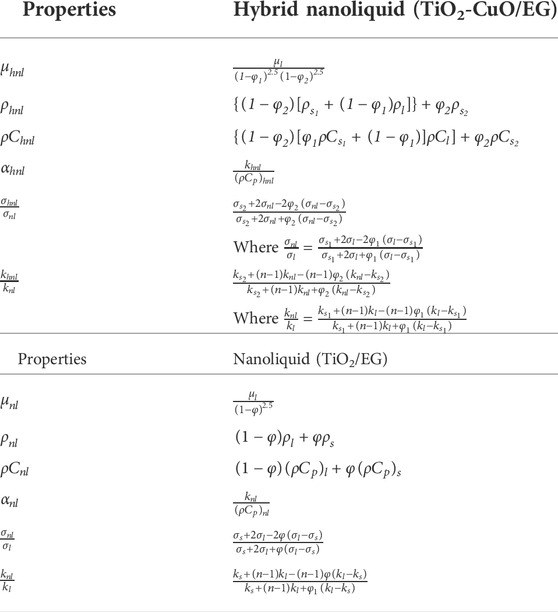
TABLE 2. Thermophysical properties of hybrid nanoliquid and nanoliquid Al-Mdallal et al. (2020).
The radiative heat flux
The Stefen–Boltzmann constant and the mean absorption coefficient, respectively, are
Using transformation of similarity Eqs 3–5, 7 becomes
with boundary conditions,
Initially,
In Eqs 8–10 the superscripts denote differentiation with respect to
Physical quantities skin friction coefficient
Using transformation of similarity Eqs 6, 10 becomes
and local Nusselt number Nu is described as
3 Numerical simulation methodology
The numerical results for cupric oxide—titania/ethylene glycol and titania/ethylene glycol are obtained using MATLAB’s bvp4c function. The work findings are presented graphically, with a focus on the model’s mathematical key components and their effects on velocity, temperature, and engineering interest quantities. The first step is to make a first-order scheme of ODEs out of the third order ODEs (8) to (10).
with limiting equations
The function bvp4c requires a first try at the answer because the tolerance for the current issue is set to 10–8. The assumption we made must adhere to the solution’s behaviour and satisfy the boundary conditions (26) and (27). Eqs 19–25 are numerically designed in order to get the original value argument to a conclusion. The bvp4c function in the MATLAB software is used to make both of these simplifications.
4 Results and discussion
It should be noted that in the current work, ethylene glycol (C2H6O2) is first mixed with nanosized cupric oxide (CuO) particles and then fixed
Figure 2 depicts the velocity variation with magnetic parameter M. It is evident that as the magnetic parameter increases, the velocity increases as well for the TiO2/C2H6O2 and TiO2-CuO/C2H6O2 hybrid nanoliquids. This is due to the Lorentz force, which results in a retarded force on the velocity profile when a magnetic field is present. Moreover, as observed from the figure, the increment is similar for both TiO2/C2H6O2 and TiO2-CuO/C2H6O2.
Figure 3 depicts how the porosity parameter
The effect of the magnetic parameter M on the thermal distribution is seen in Figure 4. The graph shows that when magnetic parameter values increase, temperature profiles decrease for the TiO2-CuO/C2H6O2 hybrid nanoliquid and the TiO2/C2H6O2 nanoliquid. The strong Lorentz force that causes the fluid flow to slow down as a result of the increased development of resistance temperature is caused up to
Figure 5 shows how the Eckert number Ec affects the temperature profile. The Eckert number illustrates the function-versus-viscous fluid tension conversion of external energy into internal energy, which causes the process to be irreversible. It has been established that a rise in the viscous dissipation parameter is accompanied by a rise in temperature. From Figure 5. It is noted that for higher values of the Eckert number, the thermal distribution is a little higher for TiO2-CuO/C2H6O2 nanoliquid than for TiO2/C2H6O2 nanoliquid.
On the other hand, Figure 6. Reveals that the increasing values of radiation parameter (R) result in the increasing temperature distribution of the TiO2-CuO/C2H6O2 hybrid nanoliquid and the TiO2/C2H6O2 nanoliquid flow region. This is because there would be an increase in the thermal boundary layer thickness with the increase of radiation parameter R.
Figure 7 illustrates how the porosity
Figures 8–10 show hybrid nanoliquid and nanoliquid skin friction past a wedge. It is revealed from Figures 8–10 that the increasing values of porosity
Figures 11, 12 illustrate the TiO2-CuO/EG hybrid nanoliquid and the TiO2/EG nanoliquid Nusselt number over the wedge for the increment of R,
5 Conclusion
The momentum and thermal behaviour of viscous dissipative mono and hybrid nanofluids
1) The velocity increases when M is increased and decreases when
2) For
3) An increase in the values of
4) A local Nusselt number is an increasing function for the increasing values of R and
5) Both the skin friction and Nusselt number increase with the effect of m.
6) Greater values of Ec lower the Nusselt number for both
7) While comparing the
Data availability statement
The original contributions presented in the study are included in the article/Supplementary Materials, further inquiries can be directed to the corresponding author.
Author contributions
All authors listed have made a substantial, direct, and intellectual contribution to the work and approved it for publication.
Funding
This study was supported by the Research Fund for International Scientists (RFIS), National Natural Science Foundation of China (Grant Nos. 12150410306), the National Natural Science Foundation of China (Grant Nos. 11971375) and the China Postdoctoral Science Foundation (Grant Nos. 2019M663653). The funding body did not play any role in the design of the study and in writing the manuscript.
Conflict of interest
The authors declare that the research was conducted in the absence of any commercial or financial relationships that could be construed as a potential conflict of interest.
Publisher’s note
All claims expressed in this article are solely those of the authors and do not necessarily represent those of their affiliated organizations, or those of the publisher, the editors and the reviewers. Any product that may be evaluated in this article, or claim that may be made by its manufacturer, is not guaranteed or endorsed by the publisher.
References
Adewale, F. J., Lucky, A. P., Oluwabunmi, A. P., and Boluwaj, E. F. (2017). Selecting the most appropriate model for rheological characterization of synthetic based drilling mud. Int. J. Appl. Eng. Res. 12 (18), 7614–7629.
Ahmadi, M. H., Mirlohi, A., Nazari, M. A., and Ghasempour, R. (2018). A review of thermal conductivity of various nanofluids. J. Mol. Liq. 265, 181–188. doi:10.1016/j.molliq.2018.05.124
Ahmad, M., El-Zahar, E. R., Al-Khaled, K., Rasheed, M., Khan, S. U., Taj, M., et al. (2022). Forced convection three-dimensional Maxwell nanofluid flow due to bidirectional movement of sheet with zero mass flux. Int. Commun. Heat Mass Transf. 135, 106050. doi:10.1016/j.icheatmasstransfer.2022.106050
Al-Mdallal, Q. M., Indumathi, N., Ganga, B., and Abdul Hakeem, A. K. (2020). Marangoni radiative effects of hybrid-nanofluids flow past a permeable surface with inclined magnetic field. Case Stud. Therm. Eng. 17, 100571. doi:10.1016/j.csite.2019.100571
Aladdin, N. A. L., and Bachok, N. (2020). Boundary layer flow and heat transfer of Al2O3-TiO2/Water hybrid nanofluid over a permeable moving plate. Symmetry 12, 1064. doi:10.3390/sym12071064
Algehyne, E. A., Wakif, A., Rasool, G., Saeed, A., and Ghouli, Z. (2022). Significance of Darcy-forchheimer and Lorentz forces on radiative alumina-water nanofluid flows over a slippery curved geometry under multiple convective constraints: A renovated buongiorno’s model with validated thermophysical correlations. United Kingdom: Waves in Random and Complex Media. doi:10.1080/17455030.2022.2074570
Alghamdi, M., Wakif, A., Thumma, T., Khan, U., Baleanu, D., and Rasool, G. (2021). Significance of variability in magnetic field strength and heat source on the radiative-convective motion of sodium alginate-based nanofluid within a Darcy-Brinkman porous structure bounded vertically by an irregular slender surface. Case Stud. Therm. Eng. 28, 101428. doi:10.1016/j.csite.2021.101428
Alhowaity, A., Bilal, M., Hamam, H., Alqarni, M. M., Mukdasai, K., and Ali, A. (2022). Non-Fourier energy transmission in power-law hybrid nanofluid flow over a moving sheet. Sci. Rep. 12, 10406. doi:10.1038/s41598-022-14720-x
Ali, M., and Abdul Alim, Md. (2022). Influence of slip parameter, viscous dissipation and joule heating effect on boundary layer flow and heat transfer over a power-law stretching wedge-shaped surface with the correlation coefficient and multiple regressions. Int. J. Appl. Mech. Eng. 27 (2), 1–21. doi:10.2478/ijame-2022-0016
Animasaun, I. L., Shah, N. A., Wakif, A., Mahanthesh, B., Sivaraj, R., and Koriko, O. K. (2022). Ratio of momentum diffusivity to thermal diffusivity: Introduction, meta-analysis, and scrutinization. New York: Chapman and Hall/CRC. -13: 978-1032108520.
Ashraf, M. U., Qasim, M., Wakif, A., Afridi, M. I., and Animasaun, I. L. (2022). A generalized differential quadrature algorithm for simulating magnetohydrodynamic peristaltic flow of blood-based nanofluid containing magnetite nanoparticles: A physiological application. Numer. methods partial Differ. equations 38 (3), 666–692. doi:10.1002/num.22676
Chamkha, A. J., Al-Mudhaf, A. F., and Pop, I. (2006). Effect of heat generation or absorption on thermophoretic free convection boundary layer from a vertical flat plate embedded in a porous medium. Int. Commun. Heat Mass Transf. 33 (9), 1096–1102. doi:10.1016/j.icheatmasstransfer.2006.04.009
Chamkha, A. J., and Ben-Nakhi, A. (2008). MHD mixed convection–radiation interaction along a permeable surface immersed in a porous medium in the presence of Soret and Dufour’s Effects. Heat. Mass Transf. 44 (7), 845–856. doi:10.1007/s00231-007-0296-x
Chamkha, A. J., Mujtaba, M., Quadri, A., and Issa, C. (2003). Thermal radiation effects on MHD forced convection flow adjacent to a non-isothermal wedge in the presence of a heat source or sink. Heat Mass Transf. 39, 305–312. doi:10.1007/s00231-002-0353-4
Chamkha, A. J. (1997a). Non-Darcy fully developed mixed convection in a porous medium channel with heat generation/absorption and hydromagnetic effects. Numer. Heat. Transf. Part A Appl. 32 (6), 653–675. doi:10.1080/10407789708913911
Chamkha, A. J. (1997b). MHD-free convection from a vertical plate embedded in a thermally stratified porous medium with Hall effects. Appl. Math. Model. 21 (10), 603–609. doi:10.1016/s0307-904x(97)00084-x
Chamkha, A. J. (2000). Thermal radiation and buoyancy effects on hydromagnetic flow over an accelerating permeable surface with heat source or sink. Int. J. Eng. Sci. 38 (15), 1699–1712. doi:10.1016/s0020-7225(99)00134-2
Chamkhax, A. J. (1996). Non-Darcy hydromagnetic free convection from a cone and a wedge in porous media. Int. Commun. Heat Mass Transf. 23 (6), 875–887. doi:10.1016/0735-1933(96)00070-x
Cui, J., Razzaq, R., Farooq, U., Khan, W. A., Farooq, F. B., and Muhammad, T. (2022). Impact of non-similar modeling for forced convection analysis of nano-fluid flow over stretching sheet with chemical reaction and heat generation. Alexandria Eng. J. 61 (6), 4253–4261. doi:10.1016/j.aej.2021.09.045
Eshgarf, H., Kalbasi, R., Maleki, A., Shadloo, M. S., and Karimipour, A. (1959–1983). A review on the properties, preparation, models and stability of hybrid nanofluids to optimize energy consumption. J. Therm. Anal. Calorim. 144, 1959–1983. doi:10.1007/s10973-020-09998-w
Hamad, N. H., Wakif, A., and Alshehri, A. (2022). Towards the dynamics of a radiative-reactive magnetized viscoelastic nanofluid involving gyrotactic microorganisms and flowing over a vertical stretching sheet under multiple convective and stratification constraints. United Kingdom: Waves in Random and Complex Media. doi:10.1080/17455030.2022.2100944
Haq, E. U., Khan, S. U., Abbas, T., Smida, K., Hassan, Q. M. U., Ahmad, B., et al. (2022). Numerical aspects of thermo migrated radiative nanofluid flow towards a moving wedge with combined magnetic force and porous medium. Sci. Rep. 12, 10120. doi:10.1038/s41598-022-14259-x
Hoi, S. M., Ooi, E. H., Chew, I. M. L., and Foo, J. J. (2022). SPTV sheds light on flow dynamics of fractal-induced turbulence over a plate-fin array forced convection. Sci. Rep. 12, 76. doi:10.1038/s41598-021-02872-1
Holden, M. S. (1970). Theoretical and experimental studies of the shock waveboundary layer interaction on compression surfaces in hypersonic flow. Aerospace Research Laboratories, Wright-Patterson AFB. Technical Report ARL 70-0002.
Iqbal, Z., Khan, M., and Ahmed, A. (2020). Burgers fluid flow in perspective of Buongiorno’s model with improved heat and mass flux theory for stretching cylinder. Eur. Phys. J. Appl. Phys. 92 (3), 31101. doi:10.1051/epjap/2020200286
Iqbal, Z., Khan, M., Ahmed, A., and Nadeem, S. (2020). Features of thermophoretic and Brownian forces in Burgers fluid flow subject to Joule heating and convective conditions. Phys. Scr. 96 (1), 015211. doi:10.1088/1402-4896/abc381
Jha, B. K., and Aina, B. (2018). Impact of induced magnetic field on magnetohydrodynamic (MHD) natural convection flow in a vertical annular micro-channel in the presence of radial magnetic field. Propuls. Power Res. 7 (2), 171–181. doi:10.1016/j.jppr.2018.04.004
Kandasamy, R., Muhaimin, I., and Rosmila, A. K. (2014). The performance evaluation of unsteady MHD non-Darcy nanofluid flow over a porous wedge due to renewable (solar) energy. Renew. Energy 64, 1–9. doi:10.1016/j.renene.2013.10.019
Khan, U., Zaib, A., Khan, I., Baleanu, D., and Nisar, K. S. (2020). Enhanced heat transfer in moderately ionized liquid due to hybrid Mo2/SiO2 nanofluids exposed by nonlinear radiation: Stability analysis. Crystals 10 (142), 1–22. doi:10.3390/cryst10020142
Khan, U., Zaib, A., Abu Bakar, S., and Ishak, A. (2022). Forced convection flow of water conveying AA7072 and AA7075 alloys-nanomaterials on variable thickness object experiencing Dufour and Soret effects. Sci. Rep. 12, 6940. doi:10.1038/s41598-022-10901-w
Khashi'ie, N. S., Waini, I., Kasim, A. R. M., Zainal, N. A., Arifin, N. M., and Pop, I. (2022). Thermal progress of a non-Newtonian hybrid nanofluid flow on a permeable Riga plate with temporal stability analysis. Chin. J. Phys. 77, 279–290. doi:10.1016/j.cjph.2022.03.019
Khurana, D., Choudhary, R., and Subudhi, S. (2017). A critical review of forced convection heat transfer and pressure drop of Al2O3, TiO2 and CuO nanofluids. Heat. Mass Transf. 53, 343–361. doi:10.1007/s00231-016-1810-9
Koriko, O. K., Adegbie, K. S., Shah, N. A., Animasaun, I. L., dejoke, A., and Olotu, M. A. (2021). Numerical solutions of the partial differential equations for investigating the significance of partial slip due to lateral velocity and viscous dissipation: The case of blood‐gold Carreau nanofluid and dusty fluid. Numer. Methods Partial Differ. Equations. 1–29. doi:10.1002/num.22754
Kumar, K. G., Reddy, M. G., Sudharani, M. V. V. N. L., Shehzad, S. A., and Chamkha, A. J. (2020). Cattaneo–Christov heat diffusion phenomenon in Reiner–Philippoff fluid through a transverse magnetic field. Phys. A Stat. Mech. its Appl. 541, 123330. doi:10.1016/j.physa.2019.123330
Lin, H. T., and Lin, L. K. (1987). Similarity solutions for laminar forced convection heat transfer from wedges to fluids of any Prandtl number. Int. J. Heat. Mass Transf. 30, 1111–1118. doi:10.1016/0017-9310(87)90041-x
Mishra, S. R., Mathur, P., and Pattnaik, P. K. (2022). Hybrid nanofluid flow of non-Newtonian Casson fluid for the analysis of Entropy through a permeable medium. J. nanofluids 11, 328–339. doi:10.1166/jon.2022.1846
Mittal, S., Nigam, B., Prakash, A., Satsangi, S., Mahto, P. K., and Swain, B. P. (2018). Review of magnetohydrodynamics flow in nanofluids. IOP Conf. Ser. Mat. Sci. Eng. 377, 012176. doi:10.1088/1757-899x/377/1/012176
Modather, M., Rashad, A. M., and Chamkha, A. J. (2009). An analytical study of MHD heat and mass transfer oscillatory flow of a micropolar fluid over a vertical permeable plate in a porous medium. Turk. J. Eng. Env. Sci. 33, 245–257. doi:10.3906/muh-0906-31
Nishant, K., and Shriram, S. S. (2016). Influence of CuO and TiO2 nanoparticles in enhancing the overall heat transfer coefficient and thermal conductivity of water and ethylene glycol based nanofluids. Res. J. Chem. Environ. 20 (8), 24–30.
Philip, D., Myers, P. D., Alam, T. E., Kamal, R., Goswami, D. Y., and Stefanakos, E. (2016). Nitrate salts doped with CuO nanoparticles for thermal energy storage with improved heat transfer. Appl. Energy 165 (1), 225–233. doi:10.1016/j.apenergy.2015.11.045
Qawasmeh, B. R., Alrbai, M., and Al-Dahidi, S. (2019). Forced convection heat transfer of Casson fluid in non-Darcy porous media. Adv. Mech. Eng. 11 (1), 168781401881990–10. doi:10.1177/1687814018819906
Rasool, G., Shah, N. A., El-Zahar, E. R., and Wakif, A. (2022). Numerical investigation of EMHD nanofluid flows over a convectively heated riga pattern positioned horizontally in a Darcy-forchheimer porous medium: Application of passive control strategy and generalized transfer laws. United Kingdom: Waves in Random and Complex Media. doi:10.1080/17455030.2022.2074571
Romanov, A, and Kolesnikova, A. L. (2021). Elasticity boundary-value problems for straight wedge disclinations. A review on methods and results. Rev. Adv. Mat. Tech. 3, 55–95. doi:10.17586/2687-0568-2021-3-1-55-95
Shaw, S., Ramesh, K., Azam, M., and Nayak, M. K. (2022). Bodewadt flow of non-Newtonian fluid with single-walled TiO2 nanotubes suspensions. New Jersey, United States: Wiley. doi:10.1002/htj.22621
Sreedevi, P., Sudarsana Reddy, P., and Chamkha, A. (2020). Heat and mass transfer analysis of unsteady hybrid nanofluid flow over a stretching sheet with thermal radiation. SN Appl. Sci. 2, 1222. doi:10.1007/s42452-020-3011-x
Veera Krishna, M., Ameer Ahamad, N., and Chamkha, Ali J. (2020). Hall and ion slip effects on unsteady MHD free convective rotating flow through a saturated porous medium over an exponential accelerated plate. Alexandria Eng. J. 59 (2), 565–577. doi:10.1016/j.aej.2020.01.043
Veera Krishna, M., Ameer Ahamad, N., and Chamkha, Ali J. (2021). Hall and ion slip impacts on unsteady MHD convective rotating flow of heat generating/absorbing second grade fluid. Alexandria Eng. J. 60 (1), 845–858. doi:10.1016/j.aej.2020.10.013
Veera Krishna, M., and Chamkha, A. J. (2019). Hall and ion slip effects on MHD rotating boundary layer flow of nanofluid past an infinite vertical plate embedded in a porous medium. Results Phys. 15, 102652. doi:10.1016/j.rinp.2019.102652
Veera Krishna, M., and Chamkha, Ali J. (2020). Hall and ion slip effects on MHD rotating flow of elastico-viscous fluid through porous medium. Int. Commun. Heat Mass Transf. 113. 104494, doi:10.1016/j.icheatmasstransfer.2020.104494
Veera Krishna, M., Reddy, G. S., and Chamkha, A. J. (2018). Hall effects on unsteady MHD oscillatory free convective flow of second grade fluid through porous medium between two vertical plates. Phys. Fluids 30, 023106.
Wakif, A., Chamkha, A., Animasaun, I. L., Zaydan, M., Waqas, H., and Sehaqui, R. (2020). Novel physical insights into the thermodynamic irreversibilities within dissipative EMHD fluid flows past over a moving horizontal riga plate in the coexistence of wall suction and joule heating effects: A comprehensive numerical investigation. Arab. J. Sci. Eng. 45 (11), 9423–9438. doi:10.1007/s13369-020-04757-3
Wakif, A., Animasaun, I. L., Khan, U., Shah, N. A., and Thumma, T. (2021). Dynamics of radiative-reactive Walters-b fluid due to mixed convection conveying gyrotactic microorganisms, tiny particles experience haphazard motion, thermo-migration, and Lorentz force. Phys. Scr. 96 (12), 125239. doi:10.1088/1402-4896/ac2b4b
Xiu, W., Animasaun, I. L., Al-Mdallal, Q. M., Alzahrani, A. K., and Muhammad, T. (2022). Dynamics of ternary-hybrid nanofluids due to dual stretching on wedge surfaces when volume of nanoparticles is small and large: Forced convection of water at different temperatures. Int. Commun. Heat Mass Transf. 137, 106241. doi:10.1016/j.icheatmasstransfer.2022.106241
Yasir, M., Khan, M., Ahmed, A., and Hafeez, A. (2022). Analysis of forced convection phenomenon in boundary layer flow of nanofluid over power-law rotating disk. Int. J. Mod. Phys. B 36 (24), 2250161. doi:10.1142/S0217979222501612
Zaydan, M., Hamad, N. H., Wakif, A., Dawar, A., and Sehaqui, R. (2022). Generalized differential quadrature analysis of electro‐magneto‐hydrodynamic dissipative flows over a heated riga plate in the presence of a space‐dependent heat source: The case for strong suction effect. Heat. Trans. 51 (2), 2063–2078. doi:10.1002/htj.22388
Zhang, Y., Fang, J., Lei Song, R. T., and Singh, A. V. (2022). Horizontal solid burning under laminar forced convection and turbulent buoyant convection with an unheated segment. Int. Commun. Heat Mass Transf. 134, 105968. doi:10.1016/j.icheatmasstransfer.2022.105968
Nomenclature
Abbreivations
Ec Eckert number
f Fluid
F Forchheimer coefficient
K Permeability
k Thermal conductivity (W.m−1.K−1)
T Temperature (K)
Greek symbols
Subscripts
hnl Hybrid nanoliquid
l Liquid
nl Nanoliquid
S1 Hard nanoparticle of I nanoparticle of hybrid nanoliquid
S2 Hard nanoparticle of II nanoparticle of hybrid nanoliquid
Keywords: casson CuO-TiO2/C2H6O2, viscous dissipation, radiation, non-Darcy porous medium, MHD, wedge
Citation: Naik PA, Indumathi N, Ganga B, Charles S, Hakeem AKA, Iqbal Z, Tag-ElDin E and Zu J (2022) Forced convection of non-darcy flow of ethylene glycol conveying copper(II) oxide and titanium dioxide nanoparticles subject to lorentz force on wedges: Non-newtonian casson model. Front. Chem. 10:1010591. doi: 10.3389/fchem.2022.1010591
Received: 03 August 2022; Accepted: 30 August 2022;
Published: 26 September 2022.
Edited by:
Sam P. De Visser, The University of Manchester, United KingdomReviewed by:
Ali Chamkha, Kuwait College of Science and Technology, KuwaitYassine Ezaier, University Hassan II. Casablanca, Morocco, Morocco
Copyright © 2022 Naik, Indumathi, Ganga, Charles, Hakeem, Iqbal, Tag-ElDin and Zu. This is an open-access article distributed under the terms of the Creative Commons Attribution License (CC BY). The use, distribution or reproduction in other forums is permitted, provided the original author(s) and the copyright owner(s) are credited and that the original publication in this journal is cited, in accordance with accepted academic practice. No use, distribution or reproduction is permitted which does not comply with these terms.
*Correspondence: Jian Zu, jianzu@xjtu.edu.cn
 Parvaiz Ahmad Naik
Parvaiz Ahmad Naik N. Indumathi2
N. Indumathi2  Zahoor Iqbal
Zahoor Iqbal ElSayed Tag-ElDin
ElSayed Tag-ElDin